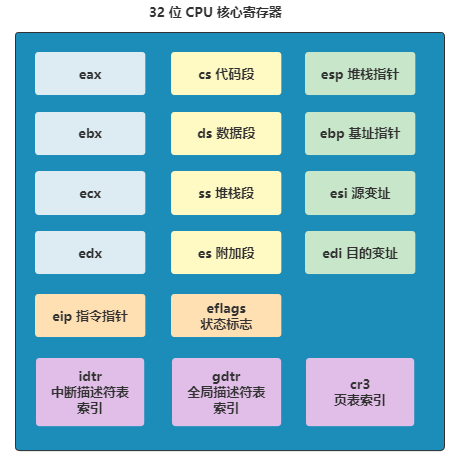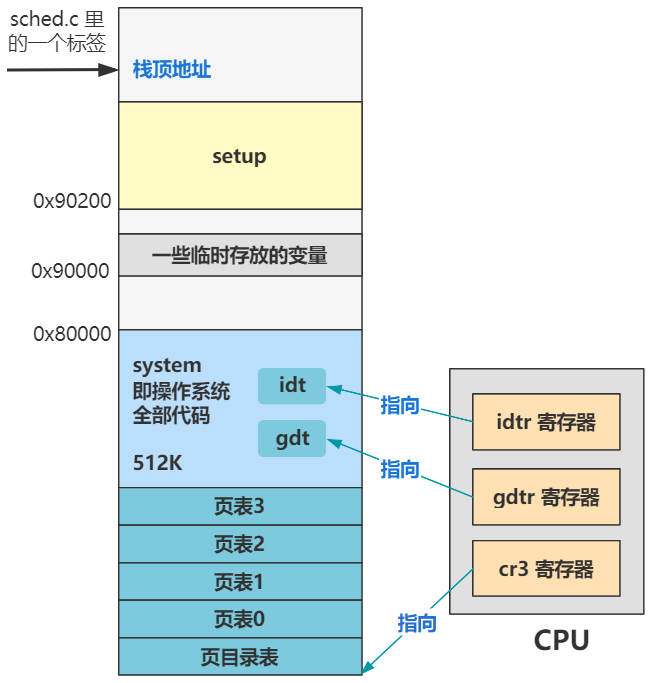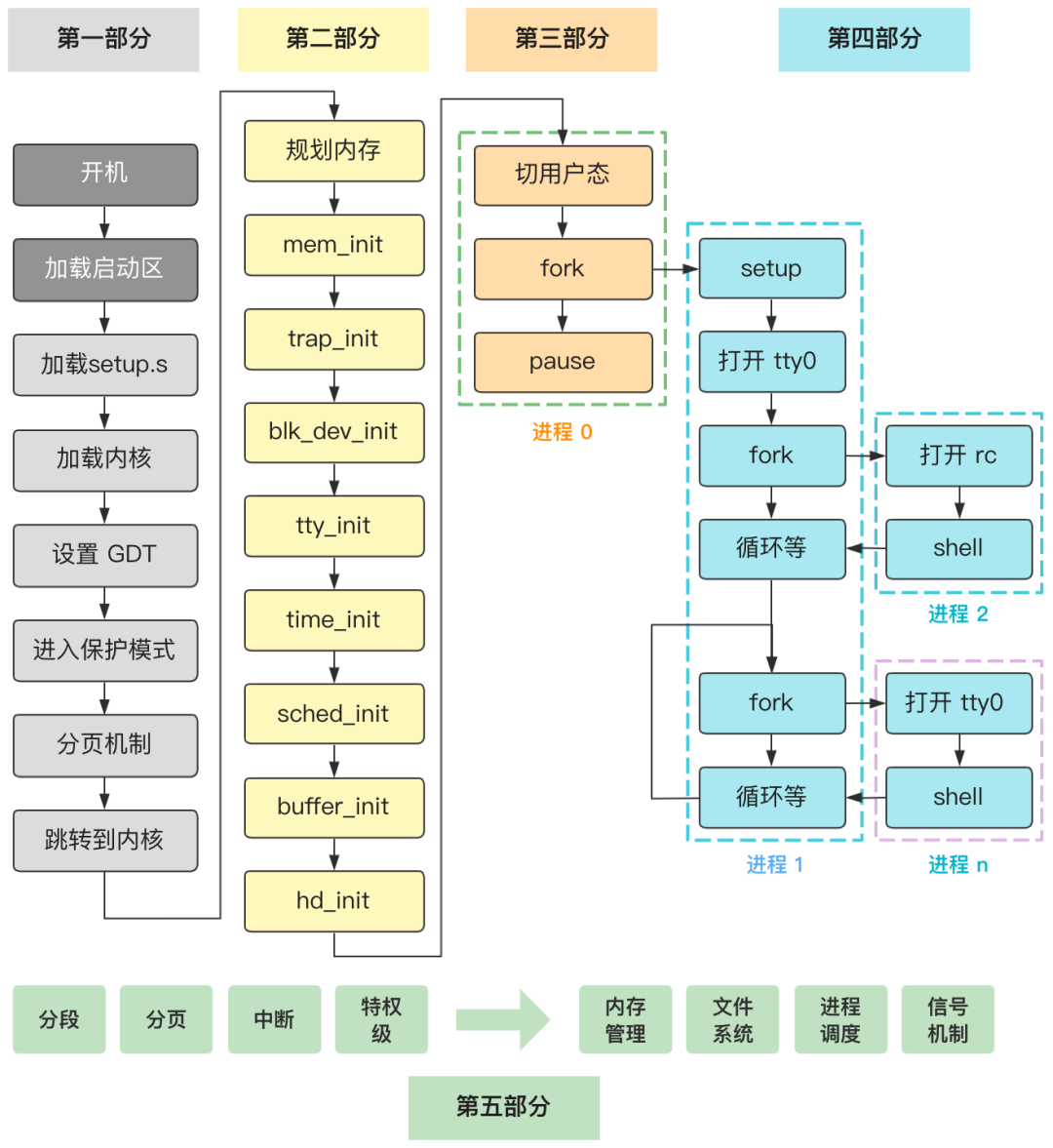一个新进程的诞生(三)如果让你来设计进程调度

本系列作为 你管这破玩意叫操作系统源码 的第三大部分,讲述了操作系统第一个进程从无到有的诞生过程,这一部分你将看到内核态与用户态的转换、进程调度的上帝视角、系统调用的全链路、fork 函数的深度剖析。
不要听到这些陌生的名词就害怕,跟着我一点一点了解他们的全貌,你会发现,这些概念竟然如此活灵活现,如此顺其自然且合理地出现在操作系统的启动过程中。
本篇章作为一个全新的篇章,需要前置篇章的知识体系支撑。
当然,没读过的也问题不大,我都会在文章里做说明,如果你觉得有困惑,就去我告诉你的相应章节回顾就好了,放宽心。
------- 第三部分目录 -------
------- 正文开始 -------
void main(void) {
...
move_to_user_mode();
if (!fork()) {
init();
}
for(;;) pause();
}今天,本来应该再往下讲 fork。

整体流程设计

struct task_struct {
?
}
上下文环境

struct task_struct {
...
struct tss_struct tss;
}
struct tss_struct {
long back_link; /* 16 high bits zero */
long esp0;
long ss0; /* 16 high bits zero */
long esp1;
long ss1; /* 16 high bits zero */
long esp2;
long ss2; /* 16 high bits zero */
long cr3;
long eip;
long eflags;
long eax,ecx,edx,ebx;
long esp;
long ebp;
long esi;
long edi;
long es; /* 16 high bits zero */
long cs; /* 16 high bits zero */
long ss; /* 16 high bits zero */
long ds; /* 16 high bits zero */
long fs; /* 16 high bits zero */
long gs; /* 16 high bits zero */
long ldt; /* 16 high bits zero */
long trace_bitmap; /* bits: trace 0, bitmap 16-31 */
struct i387_struct i387;
};

运行时间信息
struct task_struct {
...
long counter;
...
struct tss_struct tss;
}
void do_timer(long cpl) {
...
// 当前线程还有剩余时间片,直接返回
if ((--current->counter)>0) return;
// 若没有剩余时间片,调度
schedule();
}
优先级
struct task_struct {
...
long counter;
long priority;
...
struct tss_struct tss;
}
进程状态
struct task_struct {
long state;
long counter;
long priority;
...
struct tss_struct tss;
}
#define TASK_RUNNING 0
#define TASK_INTERRUPTIBLE 1
#define TASK_UNINTERRUPTIBLE 2
#define TASK_ZOMBIE 3
#define TASK_STOPPED 4
struct task_struct {
/* these are hardcoded - don't touch */
long state; /* -1 unrunnable, 0 runnable, >0 stopped */
long counter;
long priority;
long signal;
struct sigaction sigaction[32];
long blocked; /* bitmap of masked signals */
/* various fields */
int exit_code;
unsigned long start_code,end_code,end_data,brk,start_stack;
long pid,father,pgrp,session,leader;
unsigned short uid,euid,suid;
unsigned short gid,egid,sgid;
long alarm;
long utime,stime,cutime,cstime,start_time;
unsigned short used_math;
/* file system info */
int tty; /* -1 if no tty, so it must be signed */
unsigned short umask;
struct m_inode * pwd;
struct m_inode * root;
struct m_inode * executable;
unsigned long close_on_exec;
struct file * filp[NR_OPEN];
/* ldt for this task 0 - zero 1 - cs 2 - ds&ss */
struct desc_struct ldt[3];
/* tss for this task */
struct tss_struct tss;
};
------- 关于本系列的完整内容 -------
本系列的开篇词看这
本系列的扩展资料看这(也可点击阅读原文),这里有很多有趣的资料、答疑、互动参与项目,持续更新中,希望有你的参与。
https://github.com/sunym1993/flash-linux0.11-talk
本系列全局视角

最后,祝大家都能追更到系列结束,只要你敢持续追更,并且把每一回的内容搞懂,我就敢让你在系列结束后说一句,我对 Linux 0.11 很熟悉。
公众号更新系列文章不易,阅读量越来越低,希望大家多多传播,不方便的话点个小小的在看我也会很开心,我相信星火燎原的力量,谢谢大家咯。
另外,本系列完全免费,希望大家能多多传播给同样喜欢的人,同时给我的 GitHub 项目点个 star,就在阅读原文处,这些就足够让我坚持写下去了!我们下回见。
评论
